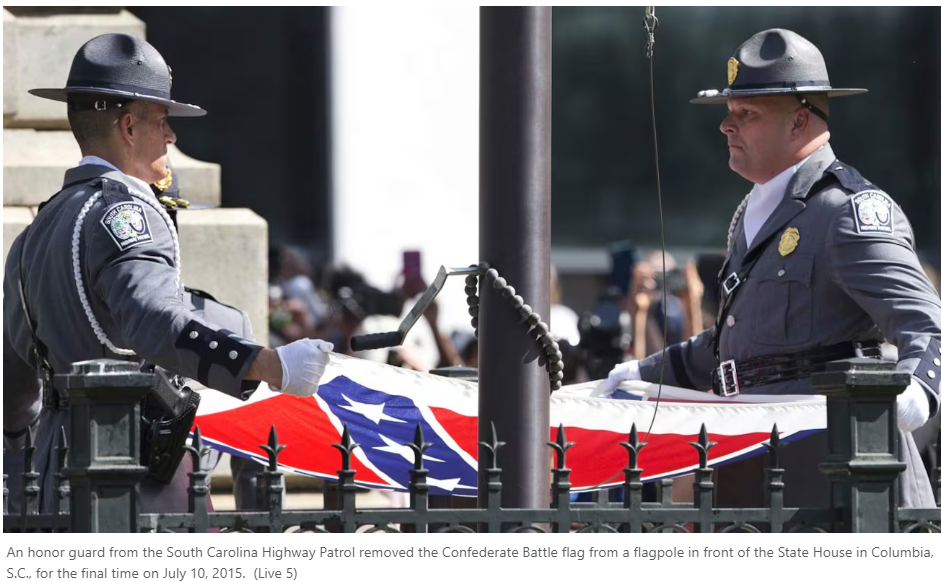The beautiful Confederate flag of Dixie is in the news again and… It is reported that a Southern Heritage group has purchased land in Richmond, Virginia to fly a 10-by-15 foot Confederate flag on Interstate 95 in the city. Susan Hathaway founder of the Virginia Flaggers said:
Do you remember those autumn days of high school and college football when…
The Ole Miss Cheerleaders and school Mascot Colonel Reb lifted the spirit of fans who waved Confederate flags and cheered when the band played Dixie? Today, however, Colonel Reb has been replaced and flag waving has been discouraged. Some call for sensitivity and understanding toward some but apparently this respect does not apply toward Southern-American’s who love God and are proud of their native Southland for which many books and movies are written about.
Do you remember when… School bands from North and South of the Mason-Dixon Line played Dixie at school sports games? Do you know the history of the song Dixie that is a joyful sound of inspiration and pride for many people? Do you know the truth about the Confederate Battle flag? Read more at:
http://georgiascv.org/pastor_weaver_cd_2.php
In 1859, Ohio Native Dan Emmett first performed “Dixie” in New York City to an enthusiastic-cheerful crowd. Two years later, on February 18, 1861, the band played Dixie at the Inauguration of Confederate President Jefferson Davis in Montgomery, Alabama.
And on April 14, 1865, after General Robert E. Lee’s surrender, President Abraham Lincoln said: “Now Let the Band Play Dixie; it belongs neither to the South, nor to the North but to us all.”-—New York Times Sunday Magazine, August 11, 1907.
For 150 years American school bands have played Dixie including the Milton High school “Dixie Eagles” Band who performed Dixie at the invitation and inauguration of the late Lester G. Maddox as Governor of Georgia in January 1967. The 1956 Georgia State flag with a Confederate flag in its design was also flying proud.
The late country music singer Johnny Cash sang Dixie at the Ford Theater in Washington, D.C. to then President Jimmy Carter and members of the United States Congress. Dixie has been performed by many great musicians including; Elvis Presley, Bob Dylan, Lawrence Welk, Louis Armstrong and the rock band Lynyrd Skynyrd who have displayed the Confederate flag at their concerts.
Roz Bowie, a proud Black Southern Lady, sang Dixie in 1986 at the reburial of a Confederate Soldier in Columbia, South Carolina.
So, what happened to the song Dixie that has lifted the souls of students, teachers, parents and fans? Many of our institutions of learning have stopped playing Dixie even though the song is universally loved.
In a cemetery in Mount Vernon Ohio lies Dan Emmett, the Composer of Dixie, whose headstone reads: “Daniel Decatur Emmett 1815 – 1904 whose song ‘Dixie Land’ inspired the courage and devotion of the Southern people and now thrills the hearts of a reunited nation.” Three miles North of Emmett’s grave are the graves of Ben and Lew Snowden of a Black musical family. On their tombstone are the words “They taught “Dixie” to Dan Emmett”. Let the Southern flag fly and let the band play Dixie!
A note about Confederate flags: The flags of the Confederacy include the 1st National flag that was called the Stars and Bars with a circle of stars and bars. This was changed because it looked a lot like the US flag on the field of battle. The 2nd National flag had the Battle flag in the upper left corner with a field of white but was changed because it looked at times like a flag of surrender. The 3rd and final National flag had the Battle flag in the upper left corner with a field of white and red bar on the right.
The Confederate Battle flag, a square shaped flag, has been called by some the Stars and Bars. The first National flag was actually the Stars and Bars and the accurate name for the Confederate Battle flag is also known as the Saint Andrews Cross. It is written that the Battle flag was born at the Battle of Manassas.
The most popular Confederate flag, besides the Battle flag–the soldier’s flag, was probably the Bonnie Blue flag that a song was made about.
Johnson is a speaker, writer of short stories, author of book “When America stood for God, Family and Country” and Chairman of the National and Georgia Division Sons of Confederate Veterans Confederate History and Heritage Month committee. http://www.facebook.com/ConfederateHeritageMonth
He lives at 1064 West Mill Drive, Kennesaw, Georgia 30152, Phone 770 330 9792 or 770 428 0978



